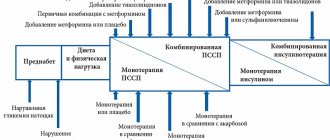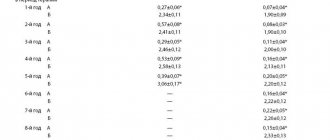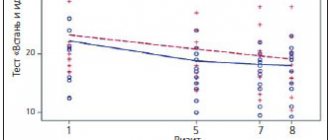Rivastigmine as a drug for basic therapy of dementia
Until recently, drug therapy for dementia at an early stage was limited to the prescription of repeated courses of nootropic and vasoactive drugs with very questionable effectiveness, and at a later stage - to the use of psychotropic drugs, primarily antipsychotics, which weakened the severity of behavioral disorders, but did not have a positive effect on long-term health. forecast. The emergence of new possibilities for the treatment and prevention of dementia allows us to formulate the concept of its basic therapy. Basic therapy should be understood as treatment methods aimed at preventing further brain damage and/or providing long-term stabilization or at least slowing down the decline in mental functions in conditions of a progressive pathological process. Ultimately, this makes it possible to maintain the patient’s independence at home for a longer period of time and delay the development of his helplessness, the development of late behavioral disorders and hospitalization in psychiatric institutions, and reduce the burden of care for relatives and social services [4,5]. Basic therapy for dementia depends on the etiology of the disease. Its capabilities are most significant in potentially reversible dementias. Removal of a tumor or hematoma, shunt surgery for hydrocephalus, replenishment of vitamin deficiency, replacement therapy for hypothyroidism, immunotropic therapy for autoimmune diseases and antibacterial therapy for infections can lead to significant or complete regression of cognitive impairment over time. For vascular dementia or mixed dementia with a vascular component, basic therapy includes the need for earlier adequate correction of vascular risk factors, including antihypertensive therapy, treatment of dyslipidemia and metabolic syndrome, correction of hyperhomocysteinemia and diabetes mellitus, smoking cessation, etc., prevention of relapses ischemic episodes through long-term use of antiplatelet agents (primarily small doses of acetylsalicylic acid) [5]. For dementia of various etiologies (Alzheimer's disease, vascular dementia, dementia with Lewy bodies), the use of modern antidementia drugs, primarily cholinesterase inhibitors and memantine, can be considered as basic therapy. What criteria allow one or another drug that improves cognitive function to be classified as a basic therapy for dementia? First, the effectiveness of the drug must be demonstrated in multicenter placebo-controlled studies lasting at least 6 months. Secondly, the effect of the drug must be clinically significant. This means that the positive effect of the drug should be manifested not only by an improvement in cognitive functions (with neuropsychological testing), but also in the functional sphere (increased daily activity and household independence) and behavioral sphere (decreased severity of neuropsychiatric disorders). The result should be a higher (compared to placebo) assessment of the patient’s general condition (on the Clinical Global Impression scale). Thirdly, the effect of the drug must be persistent and manifest itself not only according to the data of a 6-month study, but also, preferably, in a longer term. In conditions of a progressive disease, a positive effect may consist not only in a persistent improvement in the patient’s condition, but also in stabilizing and slowing the progression of the disease, longer-term preservation of residual everyday independence, preventing the development of new behavioral complications, reducing the need for hospitalization, postponing the moment of placement of the patient in an institution for care Fourth, the persistence of the clinical effect should be determined not only by purely symptomatic, but also by pathogenetic action, which also includes the possibility of a neuroprotective effect [4]. The cholinesterase inhibitor rivastigmine certainly meets these criteria. The mechanism of action of rivastigmine, like other cholinesterase inhibitors (ChEIs), is associated with blocking the activity of this enzyme in the central nervous system, which leads to a slowdown in the breakdown of acetylcholine released by remaining intact cholinergic neurons, an increase in the duration of its action on postsynaptic receptors and thereby an increase in cholinergic transmission, weakening which is one of the most important factors in the development of dementia in a number of diseases. A decrease in the activity of the cholinergic system was noted in Alzheimer's disease (AD), dementia with Lewy bodies, Parkinson's disease with dementia, mixed dementia, and partly in vascular and post-traumatic dementia. Because of this, ChEIs turned out to be one of the most effective drugs that can help with all major nosological forms of dementia [36]. Historically, the first ChEI used in clinical practice to improve cognitive function was physostigmine, but its use was limited by severe side effects [18]. The first ChEI that became widely used in clinical practice for the treatment of asthma was tacrine, but at present it is practically not used due to hepatotoxicity. Rivastigmine has been used in clinical practice since the 90s of the 20th century. [30,32]. Rivastigmine is a carbamate derivative and, along with physostigmine, is a pseudoreversible ChEI. By binding to and slowly dissociating from acetylcholinesterase (AChE), rivastigmine has a longer-lasting effect than reversible AChE inhibitors, such as donepezil, and rivastigmine selectively acts on the AChE G1 isoenzyme present in the central nervous system [22]. AChE inhibition is dose-dependent. After oral administration of 3 mg of rivastigmine, AChE activity in the cerebrospinal fluid decreases in the first 1.5 hours by approximately 40% and returns to the initial level only after 10 hours. In addition to AChE, rivastigmine also inhibits butyrylcholinesterase (BChE), thus having a dual effect [ 3]. Due to the inhibition of BChE, whose activity increases as dementia progresses, rivastigmine may have a longer “therapeutic window” and have a longer-term effect in dementia than drugs that non-selectively inhibit AChE, the activity of which in the brain decreases over time [3]. To date, the results of a number of 6-month randomized, double-blind, placebo-controlled studies have been published confirming the effectiveness of rivastigmine in AD patients with mild to moderate dementia. A meta-analysis of 9 studies, including 4775 patients, showed that rivastigmine not only improves performance on neuropsychological tests, but also slows the increase in functional deficits and behavioral disorders, and improves the general condition of patients. The drug increases the degree of everyday independence of patients and reduces the need for care. Analysis of the dynamics of individual cognitive functions in the process of controlled studies shows that the greatest improvement is observed in tests assessing attention, regulatory and visuospatial functions. By reducing the severity of behavioral disorders, the need for antipsychotics is reduced, the use of which may be associated with a worse long-term prognosis. It is important to note that with a decrease in behavioral disorders, the work of caregivers is significantly easier [11,13,14,37]. The clinical effect is clearly dose-dependent. When using a higher dose of the drug (6–12 mg/day), a more significant improvement in cognitive functions and daily activity was noted [11]. Although the initially achieved effect in conditions of progressive disease may be exhausted over time, a number of studies have shown that in a significant proportion of patients it persists for quite a long time. The level of effectiveness achieved in the first 6 months (in the form of slowing down the increase in cognitive and functional impairments) is maintained in some patients over a 5-year period [32]. If in untreated patients over 3 years the MMSE score should have decreased by an average of 9 points, then in patients taking rivastigmine, even at the end of the 5-year period, the average MMSE score decreased by slightly more than 8 points, being above the critical line in 10–12 points, below which severe behavioral disorders develop, greatly complicating patient care. When using a higher dose of the drug (6–12 mg/day), a more distinct tendency towards stabilization of mental status in the long term was noted. Slowing the rate of cognitive decline can be considered as a very desirable result in the treatment of a progressive disease, as it allows caregivers to adapt to a certain situation, reduce their distress, delay the point at which the patient has to be admitted to a care facility. Long-term treatment with rivastigmine for a year was accompanied by maintenance of a higher level of cortex metabolism than in the absence of treatment [34]. Long-term therapy with rivastigmine reduced the risk of developing delirium in elderly people with dementia [15]. Moreover, rivastigmine may be useful in patients with established stroke-related delirium [29]. The open-label phase of the study, which involved continuation of rivastigmine in patients who started treatment in the blinded phase of the study, and de novo administration of rivastigmine to patients previously treated with placebo, led to the conclusion that earlier treatment with rivastigmine leads to relative stabilization at higher levels of cognitive performance. functions. However, the difference between the groups of patients who started treatment with rivastigmine (and took it at a dose of 6-12 mg / day) or placebo persisted in the long term, despite the fact that all patients received the same therapy in the open phase. This emphasizes the importance of early initiation of basic therapy immediately after the diagnosis of dementia and achievement of target doses of the drug [11]. Confirmation of a wider therapeutic window for rivastigmine can be provided by data from a retrospective analysis of 3 placebo-controlled studies that included patients with mild to moderate dementia, showing that at a dose of 6–12 mg/day. Rivastigmine may be effective in both higher and lower levels of cognitive deficits [13,20]. The effectiveness of the drug is currently being studied in patients with severe asthma. Maintaining a long-term therapeutic effect can also be achieved by combining rivastigmine with memantine. T. Dantoine et al. (2006), having examined a series of patients with asthma resistant to donepezil and galantamine, noted an improvement in almost half of these patients when switching to rivastigmine monotherapy and in almost 80% when prescribing a combination of rivastigmine and memantine [4]. Placebo-controlled studies have shown the effectiveness of rivastigmine in Parkinson's disease with dementia, dementia with Lewy bodies, post-traumatic encephalopathy, and Huntington's disease [16,19,27,28,31]. Open studies have demonstrated the possible effectiveness of rivastigmine in vascular dementia and Korsakoff's amnestic syndrome [36]. In the largest placebo-controlled study to date, including patients with dementia with Lewy bodies, rivastigmine was shown to cause a 30% improvement in cognitive function when assessed using maximally objective computerized neuropsychological tests [27]. A placebo-controlled study demonstrated the effectiveness of rivastigmine in Parkinson's disease with dementia. The drug was well tolerated - only 10% of patients showed increased tremor, which did not require adjustments in treatment [19]. It has been shown that rivastigmine may also be useful in Huntington's disease, having a positive effect not only on cognitive but also on motor functions [16,17]. A well-organized placebo-controlled study by Vantag E. showed that in patients with cerebrovascular pathology, rivastigmine has a positive effect in those patients who have concomitant Alzheimer's pathology [9]. Rivastigmine is the only drug with a proven effect in a placebo-controlled study on moderate to severe memory impairment in patients who have suffered severe TBI [31]. The long-term effect, combined with an acceptable frequency of side effects, allows the use of rivastigmine as a drug for basic therapy in AD, dementia with Lewy bodies, Parkinson's disease with dementia, and mixed dementia. Pharmacoeconomic analysis shows that the economic benefit, determined by slowing down cognitive decline and delaying the moment of placement in a psychoneurological boarding school with long-term use of the drug, exceeds the costs of treatment [25]. Unfortunately, none of the currently existing antidementia drugs used in the basic treatment of dementia provides a guaranteed result. A conclusion about the effectiveness of rivastigmine and the need for its long-term use can only be made after trial therapy, which should last at least 3 months. Assessing the effectiveness of the drug should take into account the dynamics of cognitive, functional and behavioral disorders [5]. Comparative studies have not shown any advantage in the effectiveness of one ChEI drug over another [8,37]. However, the EXCEED trial showed a benefit for rivastigmine in patients with more rapid progression of cognitive impairment. 56% of patients with asthma who stopped taking donepezil due to ineffectiveness or side effects received a positive result from switching to rivastigmine [8]. Rivastigmine has been shown to remain effective for at least 2 years in people with moderate asthma, providing better levels of daily activity and overall functioning than donepezil, although the drugs' effects on cognition and behavioral impairment were comparable [12]. During long-term administration of rivastigmine, low ChE activity in plasma and CSF persists for at least 12 months. This contrasts with data obtained with other ChEIs, which indicate the possibility of a rebound increase in ChEI activity, which may explain the short-lived effect of these drugs [12]. Using modern neuroimaging methods, it has been shown that while taking rivastigmine in patients with AD, the process of white matter atrophy slows down, which, along with experimental data, indicates the neuroprotective potential of the drug [3]. Predictors of a long-term positive effect of rivastigmine can be a high rate of progression, more pronounced clinical manifestations of cholinergic deficiency, including impaired attention, apathy, anxiety, and psychomotor impairment [7,10,21,26,35]. A meta-analysis of studies of rivastigmine in AD and Parkinson's disease showed that patients with hallucinations reflecting more severe cholinergic deficits could expect a particularly significant response [35]. A comparison of the effectiveness of 2-year therapy with rivastigmine and donepezil in patients with asthma showed that rivastigmine had a more significant effect and was better tolerated in the presence of clinical signs of Lewy body disease [12]. The proven effectiveness of ChEIs in AD led to large-scale placebo-controlled clinical trials that were designed to demonstrate the ability of ChEIs to slow the conversion of mild cognitive impairment (MCI) to AD. Primary statistical analyzes were unable to confirm this hypothesis, but a major reason for the failure of these studies may have been the heterogeneity of patients with MCI: the ability to reduce the incidence of dementia was demonstrated more clearly in patients with MCI, who have a particularly high risk of conversion to dementia. A retrospective analysis of the InDDex trial, which failed to demonstrate that rivastigmine reduced the risk of dementia, nevertheless found that among women at higher risk of dementia, the incidence of dementia was lower with rivastigmine than with placebo. Why exactly were women sensitive to rivastigmine therapy? In the last decade, it has become obvious that the drug has a particularly significant clinical effect with more active disease progression. Genetic studies have shown that one of the important factors in the rapid progression of AD and dementia with Lewy bodies was the presence of an allele encoding a more active form of the enzyme butyrylcholinesterase, which plays an important role not only in the metabolism of acetylcholine, but also in the development of degenerative Alzheimer's changes in the brain. Therefore, rivastigmin, acting, unlike galantamine and dimensional, not only on acetylcholinersterand, but also on bootryllycholinersterase, can have an advantage with the rapidly progressing version of degenerative dementia [23]. In the INDDEX study, it was shown that in the presence of 2 WT -allles in the genotype, the boutircholinerosis genes, which is accompanied by a higher activity of the enzyme in the brain, noted a higher UKR conversion frequency and a faster functional decrease, and this effect was significantly greater in the extent women than men. Thus, the gender factor modified the effect of the genotype on the clinical picture of the disease. A special study showed that women with this genotype when taking rivastigmin not only have the lowest probability of UKR conversion in BA, but also the lower rate of cerebral atrophy, including white atrophy (according to MRIM -Mordorphometry), that is, it is not manifested Only the purely symptomatic effect of the drug, but also its ability to modify the course of the disease. As in the case of other cholinomimetics, when using rivastigmin, caution should be observed in patients with syndrome of the weakness of the sinus node and a violation of heart conduction (for example, atrioventricular blockade), bronchial asthma and bronchus -structural diseases, in people predisposed to obstruction of the urinary tract and epileptic seizures. Rivastigmin is quickly and completely absorbed from the gastrointestinal tract. The peak of plasma concentration is achieved within 1 hour. The drug is rapidly metabolized, the period of its half -life in plasma is only 1 hour. Rivastigmine hydrolysis products are excreted with the kidneys. Thus, there is no tendency to cumulation of the drug with its prolonged use. Rivastigmin practically does not interact with other drugs, since it is minimal metabolized by the enzymes of cytochrome P450 and to a small extent is associated with plasma proteins [24]. Currently, 2 Rivastigmin -Exelon (Novartis) and Alzensorm (Teva) have been registered in Russia. Alzenserm is produced in the form of capsules in dosages of 1.5, 3, 4.5 and 6 mg. When prescribing the drug, a gradual dose titration is necessary, starting with 1.5 mg 2 times. The dose should not be increased faster than 1 time in 2 weeks. The average effective dose is 3 mg 2 times a day. The maximum dose is 6 mg 2 times a day. Upon receipt of a favorable effect, the dose should be maintained as long as possible. The crushing of the daily dose of the drug for 3 doses per day provides better tolerance than two -time use, and allows the drug to title to a higher dose, which determines its higher effectiveness [22]. The editorial office should emphasize that the drug Alzenserm has forms of both 28 and 56 capsules, the latter is designed for a month of therapy, which increases the adherence of patients to treatment. The drug Alzenserm has proven bioequivalence to the original product, and thanks to a more affordable cost and guaranteed high quality of the drugs, Alzensorm has every chance of quickly entering the wide practice of psychiatrists and neurologists. Literature 1. Gavrilova S.I. Pharmacotherapy of Alzheimer's disease. M., 2003. - 319 p. 2. Damulin I.V. Vascular dementia and Alzheimer's disease. M., 2002. - 90 S. 3. Damulin I.V. The use of rivastigmin for dementia: from the symptomatic effect to neuroprotheres. // Journal of neurology and psychiatry named after Korsakova, 9, 2010. - S. 76–82. 4. Levin O.S. Diagnosis and treatment of dementia in clinical practice. M.: Medpress - Inform, 2009.– 255 p. 5. Levin O.S. Algorithms for diagnosis and treatment of dementia. M., Medpress - Inform, 2011– 127 p. 6. Yakhno N.N. Cognitive disorders in a neurological clinic. // Neurol Journal 2006; 11: adj. 1: 4-13. 7. Adler G, Brassen S, Chwalek K, Dieter B, Teufel M. Prediction of Treatment to Rivastigmine in Alzheimer's Dementia. J Neurol Neurosurg Psychiatry 2004; 75 (2): 292–4. 8. Auriacombe S, Pere JJ, Loria - Kanza Y, Vellas B. Efficacy and Safety of Rivastigmine in Patients with Alzheimer's Disease who Failed to Benefit From Treatment Whats Donezil. Curr Med Res Opin 2002; 18: 129–38. 9. Ballard C, Sauter M, Scheltens P, et al. Efficacy, Safety and Toleability of Rivastigmine Capsules in Paty Probable Vascular Dementia: The Vantage Study. Curr Med Res Opin 2008; 24 (9): 2561–2574. 10. Barone P., Aarsland D., Levin OS et al. Effects of Rivastigmine in Dementia Patients with Hallucinations // European Journal of Neurology, 2009– S2 - S.147. 11. Birks J, Iakovidou V, Tsolaki M. Rivastigmine for Alzheimer's Disease. Cochrane Database Syst Rev 2000; 2: CD001191. 12. Bullock R, Touchon J, Bergman H, et al. Rivastigmine and DonePezil Treatment in Moderate to Moderatel - Sever's Alzheimer's Disease Over a 2 - Year Period. Curr Med Res Opin 2005; 21 (8): 1317–27. 13. Burns A, Spiegel R, QUARG P. Efficacy of Rivastigmine in Subjects with Moderately Severe Alzheimer's Disease. Int J Geriatr Psychiatry 2004; 19 (3): 243–249. 14. Corey - Bloom J, Anand R, Veach J, et al. A RANDOMIZED TRIAL EVALUATING THE EFFICY and Safety of ENA - 713 (Rivastigmine Tartrate), A New Acetylinestrase Inhibitor, In Patients with Milde to Modereatly Severe Alzheim Er's Disease. Int J Geriat Psychopharmacol 1998; 1: 55–65. 15. Dautzenberg PL, Mulder LJ, Olde Rikkert Mg, Wouters CJ, Looneen Aj. Delirium in Elderly Hospitalized Patience: Protective Effects of Chronic Rivastigmine Usage. Int J Geriatr Psychiatry 2004; 19 (7): 641–644. 16. De Tommaso M, Difruscolo O, Sciricchio V, Specchio N, Livrea P. Two Years' Follow - Up of Rivastigmine Treatment in Hunting Disease. Clin Neuropharmacol 2007; 30: 43–46. 17. De Tommaso M, Specchio N, Sciricchio V, Difruscolo O, Specchio LM. Effects of Rivastigmine on Motor and Cognitive Impairment in Huntington's Disease. MOV Disord 2004; 19 (12): 1516–1518. 18. Drachman da, sahakian bj. Memory and Cognitive Function in the Elderly: A Preliminary Trial of Physostigmine. Arch Neurol 1980; 37: 674–675. 19. Emre M, Aarsland D, Albanese a, et al. Rivastigmine for Dementia Associated with Parkinson's Disease. N English J Med 2004; 351: 2509–2518. 20. Farlow M, Anand R, Messina Jr, Hartman R, Veach J. A 52 - Sweek Study of the Efficacy of Rivastigmine in Patience to Modesheimer's Disease. EUR Neurol 2000; 44: 236–241. 21. Farlow Mr, Small GW, QUARG P, KRAUSE A. Efficacy of rivastigmine in alzheimer's disease PATIENTS WIPID DISEASE ProgROGRESSION: Results of A META - ANALYSIS. DEMENT GERIATR COGN DISORD 2005; 20 (2-3): 192–197. 22. Feldman HH, Lane R; Study 304 Group. Rivastigmine: A Placebo Controlled Tial of Twice Daily and Three Times Daily Regimens in Pathies with Alzheimer's Disease. J Neurol Neurosurg Psychiatry 2007; 78 (10): 1056–1063. 23. Ferris S., Lane R., Sfikas N., Winblad B., Farlow M. Treatment Response to Rivastigmine in Mild Impairment: An Enhanced Statistical Modeling Approach Gender Medicine, 2009. –V.6. –N2. 24. GROSSBERG GT, Stahelin HB, Messina JC, Anand R, Veach J. Lack of Adverse Pharmacodynamic Drug Interactions with Rivastigmine and Twenty -Two Classes of Medicats. Int J Geriatr Psychiatry 2000; 15 (3): 242–247. 25. Lamb Hm, Goa Kl. Rivastigmine. A PharmacoecoConomic Review of its us in alzheimer's disease. Pharmacoeconomics 2001; 19 (3): 303–318. 26. Lemstra AW, Kuiper Rb, Schmand B, Van Gool Wa. Identification of Responders to Rivastigmine: A Prospective Cohort Study. DEMENT GERIATR COGN DISORD 2008; 25 (1): 60–66. 27. Mckeith I, del Ser t, spano p, et al. Efficacy of Rivastigmine in Dementia with Lewy Bodies: A Randomid, Double - Blind, Placebo - Controlled International Study. Lancet 2000; 356: 2031–2036. 28. Moretti R, Torre P, Vilotti C, Antonello Rm, Pizzolato G. Rivastigmine and Parkinson Dementia Complex. Expert Opin Pharmacother 2007; 8 (6): 817–829. 29. Oldenbeuving AW, De Kort PL, Jansen BP, Kappelle LJ, Roks G. A Pilot Study of Rivastigmine in the Treatment of Delirium After Stroke: A Safe Alternate. BMC Neurol 2008; 8: 34. 30. Rosler M, Anand R, Cicin - Saina, et al. Efficacy and Safety of Rivastigmine in Patience with Alzheimer's Disease: International Randomized Controlled Trial. BMJ 1999; 318: 633–638. 31. Silver JM, Kouumaras b, Chen M, et al. Effects of Rivastigmine on Cognitive Function in Patience with Traumatic Brain Injury. Neurology 2006; 67: 748–755. 32. Small GW, Kaufer D., Mendiondo et al. Cognitive Performance in Alzheimer; S Patience Receiving Rivasrigmine for up to 5 Years.//int.j.clin. Pract., 2005. - V.59. - C.473–477. 33. Sramek JJ, Anand R, Wardle TS, Irwin P, Hartman RD, Cutler NR. Safety, Toleate Trial of SDZ ENA 713 in Patents with Probable Alzheimer's Disease. Life Sci 1996; 58: 1201–7. 34. Stefanova E, Blennow K, Almkvist O, Hellstrom - Lindahl E, Nordberg A. Cerebral Glucose Metabolism, Cerebrospinal Fluid - Beta --Myloid1–42 (CSF - Ebeta42), TAU and APOLIPOPOP Rotein E Genotype in Long - Term Rivastigmine and Tacrine Treated ALZHEIMER Disease (Ad) PATIENTS. Neurosci Lett 2003; 338: 159–163. 35. Touchon J., Bergman H., Bullock R. et al. Response to Rivastigmine or DonePezil in Alzheimer's Disease with Symptoms Suggestive of Concomitant Lewy Body Pathology.//curr. Med. Res. Op., 2006. –V.22. - P.49–59. 36. Waldemar G., Dubois B., Emre M. et al. ALZHEIMER's Disease and Other Disorders Associated with Dementia.//r.hughes et al. European Handbook of Neurological Management. Oxford. Blackwell Publishing, 2006. –P.266–298. 37. Wilkinson DG, Passmore Ap, Bullock R, et al. A multinational, Randomid, 12–Week, Comparative Study of Donepezil and Rivastigmine in Paty Modeate Alzheimer's Disease. Int J Clin Pract 2002; 56 (6): 441–446. 38. Winblad b, cummings j, Andreasen N, et al. A six - month Double - Blind, Randomized, Placebo - Controlled Study of a Transdermal Patch in Alzheimer's Disease - Rivastigmine Patch Versus Capsule. Int J Geriatr Psychiatry 2007; 22 (5): 456–467.
Exelon®
Absorption
Absorption of rivastigmine from TTC Exelon® occurs slowly. After using the first dose of the drug, the time to achieve a detectable concentration of rivastigmine was 0.5-1 hour. The maximum concentration (Cmax) in plasma is achieved after 10-16 hours. After reaching Cmax, the concentration in the blood plasma slowly decreases during the remaining 24-hour period of use of TTS Exelon ®.
The equilibrium concentration of rivastigmine in the blood plasma after replacing the used Exelon® TTC with a new one slowly decreases over an average of approximately 40 minutes, until the absorption of the active substance from the newly glued Exelon® TTC begins to prevail over elimination. Thereafter, the plasma concentration of rivastigmine begins to rise slowly and again reaches a maximum after approximately 8 hours. At steady state, the lowest concentration is approximately 50% of the maximum, in contrast to oral administration, in which the plasma concentration is virtually zero between doses. Similar temporal characteristics of plasma concentrations of rivastigmine were observed with the use of TTC Exelon®, in the dose range from 4.6 mg/24 hours to 13.3 mg/24 hours. Despite the fact that the exposure (Cmax and area under the “first pass” curve through the liver).
Removal
Rivastigmine is excreted primarily by the kidneys in the form of metabolites; almost undetectable in urine unchanged. 24 hours after administration, more than 90% of the dose is eliminated. Less than 1% of the dose is excreted in feces.
Pharmacokinetics in elderly patients
In elderly patients with Alzheimer's disease, no age-related changes in rivastigmine exposure were observed when using TTC Exelon®.
Pharmacokinetics in patients with impaired liver function
The use of TTS Exelon® has not been studied in patients with impaired liver function. In patients with mild to moderate hepatic impairment, after oral administration of rivastigmine, an increase in Cmax of approximately 60% and AUC of more than 2 times was observed compared with healthy volunteers. When taking 3 mg rivastigmine as a single dose or after multiple doses of 6 mg twice daily, the clearance of rivastigmine was approximately 60-65% less in patients with mild to moderate hepatic impairment compared with healthy patients. These pharmacokinetic features do not affect the incidence and severity of adverse events.
Pharmacokinetics in patients with impaired renal function
The use of TTS Exelon® in patients with impaired renal function has not been studied. Based on population-based analyses, there was no clear effect of creatinine clearance on steady-state plasma concentrations of rivastigmine or its metabolite. In patients with impaired renal function, no dose adjustment is required.
Exelon, 1.5 mg, capsules, 28 pcs.
Rivastigmine is a selective inhibitor of brain acetyl- and butyrylcholinesterase used to treat Alzheimer's disease and dementia in Parkinson's disease. Rivastigmine slows down the destruction of the neurotransmitter acetylcholine produced by functionally intact neurons. At the same time, rivastigmine selectively increases the content of acetylcholine in the cerebral cortex and hippocampus, and thus helps to improve cholinergic nerve transmission. Exelon® may have a positive effect in reducing cognitive functions associated with acetylcholine deficiency, in particular in dementia associated with Alzheimer's disease and Parkinson's disease. In addition, there is evidence that inhibition of cholinesterases may slow the formation of amyloid-beta precursor protein fragments involved in amyloidogenesis, and thus slow the formation of amyloid plaques, which are one of the main pathological hallmarks of Alzheimer's disease.
Rivastigmine interacts with the target enzyme to form a covalent bond, which leads to temporary inactivation of the enzyme. It has been shown that in young healthy men, after taking Exelon® at a dose of 3 mg, acetylcholinesterase activity in the cerebrospinal fluid (CSF) decreases by approximately 40% during the first 1.5 hours. After achieving the maximum inhibitory effect, enzyme activity returns to baseline level after approximately 9 hours. It has been shown that the activity of butyrylcholinesterase in the CSF of young healthy volunteers is inhibited reversibly and is restored to the initial level after 3–6 hours. In patients with Alzheimer's disease, the inhibition of acetylcholinesterase activity in the CSF by rivastigmine is dose-dependent in the studied dose range (up to the highest dose - 6 mg 2 times a day). Inhibition of butyrylcholinesterase is also dose-dependent; a dose of 6 mg 2 times a day causes a decrease in enzyme activity by more than 60% compared to the original. This effect of Exelon® persisted for 12 months of therapy (the maximum period studied). Statistically significant correlations have been shown between the degree of inhibition of both CSF enzymes by rivastigmine and changes in cognitive function in patients with Alzheimer's disease; Moreover, it is the inhibition of butyrylcholinesterase in the CSF that reliably and consistently correlates with improved results of tests of memory, attention and reaction speed.
The effectiveness of Exelon® therapy for Alzheimer's disease has been shown in patients with mild to moderate dementia (10–24 points on the Mini Mental State Examination, MMSE). According to clinical studies, therapy with Exelon® leads to a significant improvement in cognitive functions (attention, memory, speech, etc.), functional status and activity in daily life, as well as a decrease in the severity of the disease and the severity of mental and behavioral manifestations (such as agitation, tearfulness, illusions, hallucinations, etc.). Studies have shown that the effect of therapy with Exelon® is observed at approximately 12 weeks and persists for 6 months of therapy, while during the control period, a deterioration in the corresponding indicators was observed in the group of patients receiving placebo.
In dementia associated with Parkinson's disease, the effectiveness of Exelon® was demonstrated in a placebo-controlled study lasting 24 weeks in patients with mild to moderate dementia (MMSE score 10–24). Patients receiving Exelon® showed a statistically significant improvement in cognitive functions (attention, memory, speech, etc.), while in patients receiving placebo, similar indicators worsened (the differences are statistically significant).





